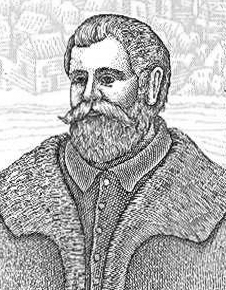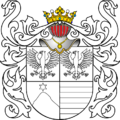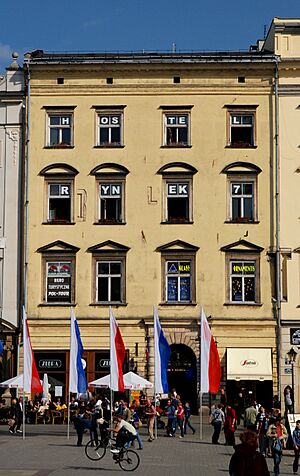Sebastiano Montelupi facts for kids
Quick facts for kids
Sebastiano Montelupi de Mari
|
|||||
|---|---|---|---|---|---|

Commemorative stamp issue, 2008 (detail).
|
|||||
| Born | 1516 | ||||
| Died | 18 August 1600 (aged 83–84) |
||||
| Monuments | Montelupi Monument, St. Mary's Basilica, Kraków | ||||
| Nationality | Polish (patent of naturalization awarded by King Sigismund II) | ||||
| Other names | Sebastian Wilczogórski | ||||
| Citizenship | Florentine (awarded 1567) | ||||
| Occupation | merchant, banker, postmaster | ||||
| Years active | 1557–1600 | ||||
| Title | Master of the Royal Posts | ||||
| Term | 1568–1600 | ||||
| Predecessor | Pietro Maffon | ||||
| Successor | Valerio Tamburini Montelupi | ||||
| Spouse(s) | Urszula Baza (1551–1586), m. 1567 | ||||
| Partner(s) | Carlo Montelupi (younger brother) | ||||
| Children | Valerio Tamburini Montelupi (adopted) | ||||
| Parent(s) | Valerio Montelupi de Mari | ||||
|
|||||
Sebastiano Montelupi (also known as Sebastian Montelupi, 1516 – August 18, 1600) was a very successful businessman. He was born in Italy but became a famous merchant and banker in Kraków, Poland. He also held a very important job: Postmaster General of the Polish royal postal service. He served under several rulers, including King Sigismund II Augustus and Queen Anna Jagiellon.
Life Story
Montelupi left his home country of Italy in 1536. He moved to the Kingdom of Poland in 1557. At first, he worked for other merchants and bankers. Later, he started his own business with his younger brother, Carlo.
In 1567, he married Urszula Baza. She was the daughter of Wojciech Baza, a doctor who worked for the royal court. A year after they got married, they moved into a large house in the center of Kraków. This building, called the Italian House or Montelupi House, also served as the main post office. Sadly, Urszula passed away in 1586 when she was 35 years old. They had been married for 19 years.
His Career
As a merchant, Montelupi traded goods with many countries. He did business with Italy, Germany, England, Austria, and Russia. As a banker, he helped manage money for important people. His clients included representatives of the Pope at the Polish court.
In 1574, the city of Kraków paid Montelupi back for his help. He had contributed to the ceremony for the new king, Henry III. This included special cloth and silver items given to the king. In 1581, Montelupi lent money to King Stephen Báthory. This money helped the king pay for a military campaign. Later in his life, Montelupi became the main banker for King Sigismund III. He also became the leader of the Italian community in the capital city. When he passed away in 1600, he left behind a very large fortune. His nephew, Valerio Tamburini Montelupi, took over his businesses. Valerio became the richest person in Kraków.
Master of the Royal Post
From 1568, Montelupi was the Postmaster General of the Polish Royal Post. This meant he was in charge of all royal mail. He managed two main postal routes. One went to Vilnius and took about three weeks. The other went to Vienna and Venice and took about ten days. These services were stopped for a short time in 1572. When they started again in 1574, they were only for royal messages.
In 1583, the new king, Stephen Báthory, confirmed Montelupi's position. The king asked him to keep public mail services running between major cities in the Polish–Lithuanian Commonwealth. He also had to make sure international mail went to and from Venice at least twice a month. Being in this position allowed Montelupi to share important information. He communicated with powerful families like the Medici in Florence.
When Sebastiano passed away, his nephew Valerio also became the Postmaster. The job stayed in their family for many years. The last postmaster from their family was Carlo Montelupi de Mari, who died in 1662. After him, another Italian, Angelo Maria Bandinelli, became the royal postmaster.
Remembering Montelupi
A beautiful monument for Sebastiano Montelupi and his wife Urszula stands in St. Mary's Basilica, Kraków. It is believed to have been made by the workshop of a famous Italian-Polish artist, Santi Gucci.
A street in Kraków is named after his family. His old house, the kamienica, is also named after him. There is even a palace built by his family members.
In 2008, special stamps were made to celebrate 450 years of the Polish postal service. These stamps featured portraits of important people, including Sebastiano Montelupi. His portrait on the stamp was based on the statue from his monument.



